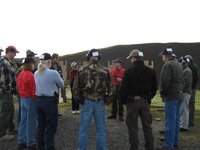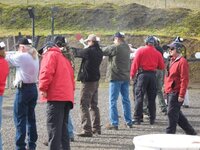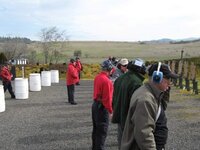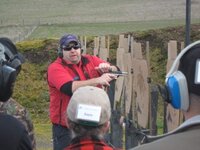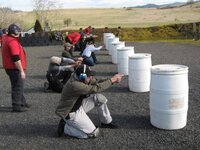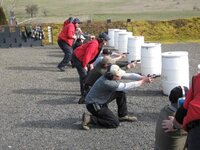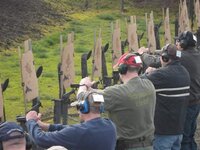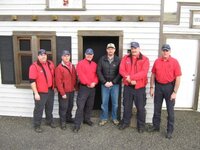I was asked several times awhile back by some folks if I could recommend Oregon Firearms Academy (OFA) as a training place to gain knowledge in the area of combat & defensive shooting. I told them I could not, only because I've not been there and witnessed in person what actually is in the curriculum and how they go about teaching it.
My background is over 20 years as a LEO, with most of that being a firearms instructor. Not only teaching for my own departments, but at the police academy, as well as being part of the cadre that helped re-write the academy firearms curriculum.
I have seen and heard what the other area training facilities programs have to offer, but have not been to Brownsville Oregon to see first hand how the ‘red shirts' go about their biz there. For those of you who haven't heard the term ‘red shirt', it refers to a firearms instructor's apparel. They most usually wear red, so they can be readily seen and identified by anyone on the range.
It just so happens that I moderate on northwestfirearms.com with one of their owners, Dan Abbott. I emailed Dan about the possibility of sitting in on a class to get first hand experience of what they are all about. He said he'd do one better than that, and offered to have me participate in their Defensive Handgun 1 class on February 21st, and who am I not to accept such an offer?
Later that same week I received a class conformation in the mail. Also included was a welcome letter outlining some of their operational rules required upon arriving for class, and a small card advertising their Pro-Shop and what they inventory.
Two weeks later I found myself on the road at 4am, to be at the facility by the 7:30 check in time. As I left the I-5 corridor, one must think "Is this a dream job or what?" Getting out of the valley into some soft rolling hills of rural life, now this is what I'm used to.
I was met in the parking area by none other than Steve Eichelberger, resident attorney, one of the firearms instructors, as well as chief parking lot attendant and tour guide. He shows the masses where and how to park in their small yet quaint facility, and shows everyone the layout and where to find everything. Dan was the next to pass his hand and welcome me to the Academy.
Though the facility is part of a large 1,000+ acre farm, the Academy encompasses only a very small portion of that, about 2-3 acres. In walking around before class, I saw a well laid out facility capable of multiple uses. The first and foremost thing that stuck out, one can actually use the range in a 180 degree manner, how many ranges can you think of that are capable of that? There's a shoot house, comfortable classroom, another building for students to get out of the weather while attending classes, storage for the range equipment, and the famous ‘fiddle table'. This is where one can go at anytime, with the instructor's knowledge, un-holster their firearm and do any manipulation while pointed in a safe direction. Most all ranges have them, but this one is very large and is somewhat isolated off in an area that allows for instructors to work with students if needed.
OFA's range layout;

Western Town which houses restrooms and wash facilities;

In the classroom are the usual long tables and chairs for students, rows of books, videos on shooting, weapon armorer information, walls decorated with awards and articles about the Academy. Then there's the Pro-Shop, where students can purchase items they forget, which I might add for a reasonable price. Most places seem to punish the student for forgetting a piece of equipment, by charging outrageous prices, you won't find that here.
The first hour of the day started in the classroom with introductions of the staff, Dan Abbott, Steve Eichelberger, Dave Young, Joe Shorten, Co-Owner Rick Benson, and later in the day Joe Picciano. Then there was the usual ceremonial waiver signing, course book handout, and safety issues to go through. If there's one thing that I encountered throughout the day, it was attention to detail with safety being number one. The staff in every facet of the day showed its colors in making sure everyone was safe, comfortable, and of course having a good time.
The class totaled 15 students, with me round it up to 16, with a make up of 12 males, and 3 females. I spoke to some throughout the day, and found most had little or no previous formal training, other than the OFA's prerequisite for this course, that being the Basic Handgun Safety course.
Dan went over the different courses that OFA offers, explaining the differences in each, and what to expect this day. This class emphasized fundamentals, with knowledge and skill being the foundation. He smoothly integrated safety issues with some firearm nomenclature, and went into Oregon law as it pertains to self defense/use of deadly force, also added what this course ultimately is designed to do; "....which is to teach the student how to defend oneself from 2 & 4 legged things."
He talked about the OFA's philosophy on "Why we do, what we do" approach, with the acronym of SUL being the basis. I've not heard this taught before, and was impressed with how they added it into the classroom portion. SUL, first off is Portuguese for the word south. SUL is a technique widely used for the firearm position to safely scan 360 degrees about you, but in this instance was used for the following in describing their litmus test to any technique they teach;
S – Safe – Is it a safe technique?
U – Universal – Is it universal to all handguns used in class?
L – Logical – Is it logical in the purpose to what is being accomplished?
Dan finished up with a short talk on attitude with the phase "I can't" being the center. He stated every student can do what will be taught that day, with emphasis on positive enforcement of the techniques. The phrase "I can't" is not allowed, and had everyone write it, circle it, then put a line through it. Off to the range we go....
My background is over 20 years as a LEO, with most of that being a firearms instructor. Not only teaching for my own departments, but at the police academy, as well as being part of the cadre that helped re-write the academy firearms curriculum.
I have seen and heard what the other area training facilities programs have to offer, but have not been to Brownsville Oregon to see first hand how the ‘red shirts' go about their biz there. For those of you who haven't heard the term ‘red shirt', it refers to a firearms instructor's apparel. They most usually wear red, so they can be readily seen and identified by anyone on the range.
It just so happens that I moderate on northwestfirearms.com with one of their owners, Dan Abbott. I emailed Dan about the possibility of sitting in on a class to get first hand experience of what they are all about. He said he'd do one better than that, and offered to have me participate in their Defensive Handgun 1 class on February 21st, and who am I not to accept such an offer?
Later that same week I received a class conformation in the mail. Also included was a welcome letter outlining some of their operational rules required upon arriving for class, and a small card advertising their Pro-Shop and what they inventory.
Two weeks later I found myself on the road at 4am, to be at the facility by the 7:30 check in time. As I left the I-5 corridor, one must think "Is this a dream job or what?" Getting out of the valley into some soft rolling hills of rural life, now this is what I'm used to.
I was met in the parking area by none other than Steve Eichelberger, resident attorney, one of the firearms instructors, as well as chief parking lot attendant and tour guide. He shows the masses where and how to park in their small yet quaint facility, and shows everyone the layout and where to find everything. Dan was the next to pass his hand and welcome me to the Academy.
Though the facility is part of a large 1,000+ acre farm, the Academy encompasses only a very small portion of that, about 2-3 acres. In walking around before class, I saw a well laid out facility capable of multiple uses. The first and foremost thing that stuck out, one can actually use the range in a 180 degree manner, how many ranges can you think of that are capable of that? There's a shoot house, comfortable classroom, another building for students to get out of the weather while attending classes, storage for the range equipment, and the famous ‘fiddle table'. This is where one can go at anytime, with the instructor's knowledge, un-holster their firearm and do any manipulation while pointed in a safe direction. Most all ranges have them, but this one is very large and is somewhat isolated off in an area that allows for instructors to work with students if needed.
OFA's range layout;
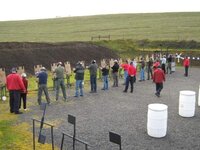
Western Town which houses restrooms and wash facilities;
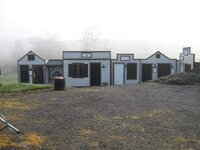
In the classroom are the usual long tables and chairs for students, rows of books, videos on shooting, weapon armorer information, walls decorated with awards and articles about the Academy. Then there's the Pro-Shop, where students can purchase items they forget, which I might add for a reasonable price. Most places seem to punish the student for forgetting a piece of equipment, by charging outrageous prices, you won't find that here.
The first hour of the day started in the classroom with introductions of the staff, Dan Abbott, Steve Eichelberger, Dave Young, Joe Shorten, Co-Owner Rick Benson, and later in the day Joe Picciano. Then there was the usual ceremonial waiver signing, course book handout, and safety issues to go through. If there's one thing that I encountered throughout the day, it was attention to detail with safety being number one. The staff in every facet of the day showed its colors in making sure everyone was safe, comfortable, and of course having a good time.
The class totaled 15 students, with me round it up to 16, with a make up of 12 males, and 3 females. I spoke to some throughout the day, and found most had little or no previous formal training, other than the OFA's prerequisite for this course, that being the Basic Handgun Safety course.
Dan went over the different courses that OFA offers, explaining the differences in each, and what to expect this day. This class emphasized fundamentals, with knowledge and skill being the foundation. He smoothly integrated safety issues with some firearm nomenclature, and went into Oregon law as it pertains to self defense/use of deadly force, also added what this course ultimately is designed to do; "....which is to teach the student how to defend oneself from 2 & 4 legged things."
He talked about the OFA's philosophy on "Why we do, what we do" approach, with the acronym of SUL being the basis. I've not heard this taught before, and was impressed with how they added it into the classroom portion. SUL, first off is Portuguese for the word south. SUL is a technique widely used for the firearm position to safely scan 360 degrees about you, but in this instance was used for the following in describing their litmus test to any technique they teach;
S – Safe – Is it a safe technique?
U – Universal – Is it universal to all handguns used in class?
L – Logical – Is it logical in the purpose to what is being accomplished?
Dan finished up with a short talk on attitude with the phase "I can't" being the center. He stated every student can do what will be taught that day, with emphasis on positive enforcement of the techniques. The phrase "I can't" is not allowed, and had everyone write it, circle it, then put a line through it. Off to the range we go....







